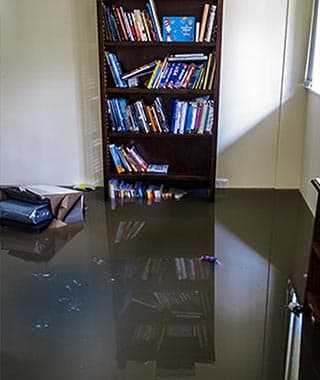Before the emergency roof tarp goes on the roof your restoration professionals need to take a few preliminary steps. They need to gauge the scope and size of the damage to accurately size the tarp. Then they will scale the roof to do a close examination. The examination will allow them to see any damage indicators as broken shingles, holes, or other wear and tear.
In addition, any debris still on the roof from the storm/natural disaster will be cleared off. It’s important to get these off before the tarp goes on because certain debris could further damage the roof or even the tarp. Generally, these include:
- Branches
- Leaves
- Rubble
- Garbage
In addition, if you see any leak, you want to cover it with plywood before the tarp goes on. After this, the damaged area will be measured out. Ideally, a roof tarp should cover the damaged area, while also offering four feet of overhang from the peak of the roof. Additional tarp can hang off the edge of the roof.
Some enterprising homeowners may want to go about checking their roofs themselves. This isn’t recommended, especially after a heavy storm. Debris, rain, and structural issues can make a roof become more slippery than usual, presenting a major fall hazard. Doing a basic visual check from the safety of your ladder is a good compromise. In addition, you should have all the safety equipment possible available, including:
- Protective clothes
- Workboots
- Gloves
- Goggles
The Roof Tarping Process Explained
With the preliminary work done, it’s time to actually put on the tarp. This begins by using some lumber and driving it into the roof, surrounding the damaged area. This wood is used to secure the tarp. Next, take the tarp that you’ve measured out using the numbers from before and wrap it around the wood. It needs to cover the entire damaged area from eaves to peak, with that additional 4 feet on each side. Pull it as tight as you can before you secure that wood to the roof deck on the opposite side.
To finish the securing process, you want to add on more lumber on each edge of the tarp, screwing it into the roof deck. Naturally, creating more leaks is a concern. This is why most experts either screw directly into the roof rafters or use screws with rubber washers. Screws are preferred because ultimately, the emergency roof tarp is a temporary measure. You want something that can be relatively easy to remove when the time comes to fixing the roof. Screws are the safest and most time-effective way to do this.
If you think this is the fit for your needs, you don’t want to waste time before getting started. At Total Care Restoration, we are here to help, with roof tarping as well as a variety of other services to get your home back to its normal state after a disaster or accident. Contact us today if you are interested in one of our suite of services, have more questions, or are looking for an estimate.
By Kyle Haywood










